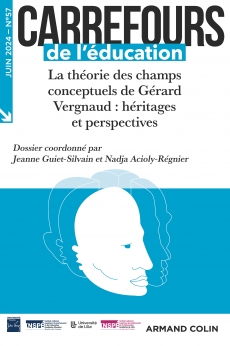
CARREFOURS DE L'ÉDUCATION N°57 (1/2024)
Pour acheter ce numéro, contactez-nous
Recevez les numéros de l'année en cours et accédez à l'intégralité des articles en ligne.
Cet article s’inscrit dans le cadre des réflexions sur les questions relatives à la conceptualisation du réel développée par G. Vergnaud. L’opérationnalité de la définition du concept fondée sur le triplet (S=signifiants, I=signifiés, S=situations) est ici remise en perspective à partir de recherches menées par les auteurs de cet article dans différents contextes de construction de connaissances. Les données révèlent que la conceptualisation produite dans des contextes scolaires versus extrascolaires produisent parfois un déséquilibre dans la place et le rôle joué par chacune des composantes du triplet (S, I, S). Ainsi ceci semble conduire au primat d’une mise en avant de l’axe signifiants-signifiés dans des contextes scolaires. En revanche, dans des contextes extrascolaires, on observe un accent dominant mis sur l’axe signifiés-situations/ référents, laissant de côté certains signifiants pourtant nécessaires à la communication et traitement de l’information de façon explicite. On observe une tendance à ce que l’ensemble des situations donnant du sens aux concepts semble dans les deux cas, réduit généralement au contexte local de production des connaissances.
This paper falls within the purview of a reflection on issues raised by the G. Vergnaud’s development of how reality is conceptualised. The operational validity of the definition of a concept as based on the triplet (S for signififiers, I for signifieds and S for situations) is put into question on the basis of the research conducted by the authors in different contexts calling for the construction of knowledge. The data show that conceptualisation produced in school contexts versus those produced in nonschool contexts sometimes lead to imbalance in the role and place of each of the components of the triplet (S,I,S). This seems to lead to favouring the high-lighting of the Signifiers-Signifieds axis in school contexts. Ad contrario, in non-school contexts, the dominant perspective is that of Signifieds-Situations-Referents, leaving to the side a certain number of signifiers nonetheless necessary for communication and for the explicit treatment of information. The tendency observed is for the totality of situations giving rise to meaningful concepts in both cases to be reduced to the local context of knowledge production.